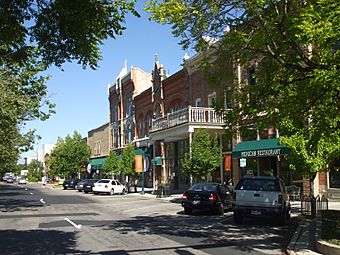Provo Downtown Historic District facts for kids
Quick facts for kids |
|
|
Provo Downtown Historic District
|
|

Provo Downtown Historic District
|
|
| Location | Center Street and University Avenue Provo, Utah |
|---|---|
| Area | 25 acres (10 ha) |
| Built | 1880-1970 |
| Architectural style | Classical Revival, Renaissance, Gothic Revival |
| NRHP reference No. | 80003980 |
| Added to NRHP | May 1, 1980 |
The Provo Downtown Historic District is a special area in Provo, Utah. It covers about 25-acre (10 ha) and is full of old, important buildings. This district is listed on the National Register of Historic Places. This means it is recognized as a place important to the history of the United States.
The district includes four blocks of Center Street and one and a half blocks of University Avenue. It has 43 buildings that help tell the story of the area. Most of these buildings were built between 1880 and 1930. Some of them are especially important because of their history or their unique design.
Contents
History of Provo's Downtown
In 1849, about 150 people came to settle the area that is now Provo. They were sent by Brigham Young, who was the leader of The Church of Jesus Christ of Latter-day Saints. He wanted them to build a new community there. The next year, the city was planned out with a main square mile. Brigham Young encouraged people to build their homes and shops in this new town.
The first shop owner in Provo was Andrew J. Stewart. He started his store in his home. Later, he moved his business to Center Street. By 1852, Provo had many businesses. These included places like pottery shops, mills for grinding grain, and shops that made furniture or shoes. There were also places to buy meat, make lime, and even two hotels. These early businesses were mostly found on 5th West and Center Street.
During the 1860s, shop owners in Utah made good money. But farmers and other church members did not earn as much. Brigham Young wanted to help them. He encouraged people to work together and trade fairly. The Provo West Co-op was the first store that followed this idea. It was built in the same building where Andrew J. Stewart used to have his shop.
Many new buildings appeared in Provo in the late 1860s. Most of these businesses were built along Center Street. They were often made from wood or adobe, which is a type of sun-dried brick. Important businesses from this time included brickyards and the Provo West Co-op. The Liddiard Brothers continued their father's cement business. They helped build many structures on Center Street. Other companies like E. J. Ward and Sons and the Provo Foundry and Machine company also grew. The Taylor family started successful businesses on the west side of downtown, like the Taylor Furniture Company.
Mining and Growth in Provo
The discovery of valuable metals like gold and silver changed Utah's economy. It went from being mostly about farming to having more industries. The Tintic Mining District was a very important mining area. It was founded in 1869 and became Utah's top mining center by 1899.
A key person in Tintic's success was Jesse Knight. He and his family lived in Provo. Jesse Knight became very wealthy from his Humbug mine in the 1890s. This mining success had a big effect on Provo's downtown. Jesse Knight, Charles E. Loose, and other rich business people made Provo their home. They used their money to make the city better.
Charles E. Loose bought many commercial properties in Provo. One example is the Loose Block. Jesse Knight built the Knight Block, which is located near Center Street and University Avenue. He also built the Knight Mansion.
Provo continued to grow and develop. In 1883, work began on a new LDS Tabernacle. In 1887, a group called a chamber of commerce was formed to help local businesses. In 1889, the Rocky Mountain Bell Telephone Company started offering phone service. The Provo Lake Resort was also built on Utah Lake, offering a place for people to relax.
District Recognition
The Provo Downtown Historic District was officially added to the National Register of Historic Places in 1980. This listing helps protect and recognize the area's important history. The district includes the Knight Block, which was already listed on the National Register by itself.
Images for kids




